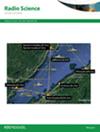荷兰-中国低频探测器的结构设计和地面性能
IF 1.6
4区 地球科学
Q3 ASTRONOMY & ASTROPHYSICS
引用次数: 0
摘要
荷兰-中国低频探测器(NCLE)(Boonstra 等人,2017 年,https://www. ursi.org/proceedings/procGA17/papers/Paper_J19-2(1603).pdf;Chen 等人,2020 年,https://ui.adsabs.harvard.edu/abs/2020AAS...23610203C/abstract)是一台用于低频范围(80 kHz-80 MHz)天体物理学研究的射电仪器。作为一项技术示范,NCLE 将为未来低频射电天文学射电接收器的设计提供参考。全国射电天文台可进行极高光谱分辨率(<1 千赫)的观测,并生成角度分辨率≈1.5 弧度的射电天空图。NCLE 使用三个单极天线(每个长 5 米)和三个相同的模拟信号链来处理来自每个天线的信号。单个数字接收器对信号进行采样,并计算自相关和交叉相关频谱。仪器的模拟和数字信号链具有广泛的可配置性。它们可以进行微调,以产生覆盖仪器整个工作频率范围或子频带的宽带光谱。NCLE 是在 2 年的极短时间内开发完成的,目前正搭载在嫦娥四号任务的中继航天器 "曲桥 "号上,处于环绕地月 L2 点的光环轨道上。本文概述了科学案例、以信号链为重点的仪器结构,并讨论了发射前阶段的实验室测量。本文章由计算机程序翻译,如有差异,请以英文原文为准。
Architecture design and ground performance of Netherlands-China low-frequency explorer
The Netherlands-China Low-Frequency Explorer (NCLE) (Boonstra et al., 2017, https://www. ursi.org/proceedings/procGA17/papers/Paper_J19-2(1603).pdf; Chen et al., 2020, https://ui.adsabs.harvard.edu/abs/2020AAS...23610203C/abstract) is a radio instrument for astrophysical studies in the low-frequency range (80 kHz-80 MHz). As a technology demonstrator, NCLE shall inform the design of future radio receivers that aim at low-frequency radio astronomy. NCLE can make observations at very high spectral resolution (<1 kHz) and generate radio sky maps at an angular resolution of ≈1.5 radians. NCLE uses three monopole antennas, each 5 m long, and three identical analog signal chains to process the signal from each antenna. A single digital receiver samples the signal and calculates the auto-correlated and cross-correlated spectra. The instrument's analog and digital signal chains are extensively configurable. They can be fine-tuned to produce broadband spectra covering the instrument's complete operating frequency range or sub-bands. NCLE was developed within a veryshort timescale of 2 years, and currently, it is on board Queqiao, the relay spacecraft of the Chang'e-4 mission, in a halo orbit around the Earth-Moon L2 point. This paper outlines the science cases, instrument architecture with focus on the signal chain, and discusses the laboratory measurements during the pre-launch phase.
求助全文
通过发布文献求助,成功后即可免费获取论文全文。
去求助
来源期刊

Radio Science
工程技术-地球化学与地球物理
CiteScore
3.30
自引率
12.50%
发文量
112
审稿时长
1 months
期刊介绍:
Radio Science (RDS) publishes original scientific contributions on radio-frequency electromagnetic-propagation and its applications. Contributions covering measurement, modelling, prediction and forecasting techniques pertinent to fields and waves - including antennas, signals and systems, the terrestrial and space environment and radio propagation problems in radio astronomy - are welcome. Contributions may address propagation through, interaction with, and remote sensing of structures, geophysical media, plasmas, and materials, as well as the application of radio frequency electromagnetic techniques to remote sensing of the Earth and other bodies in the solar system.
 求助内容:
求助内容: 应助结果提醒方式:
应助结果提醒方式:


